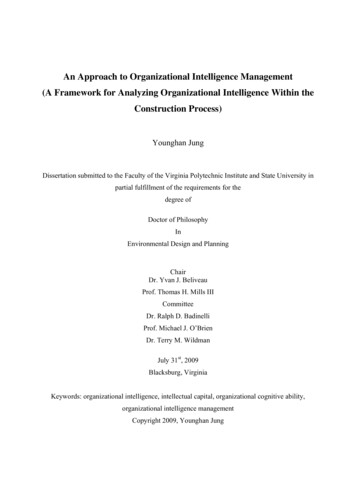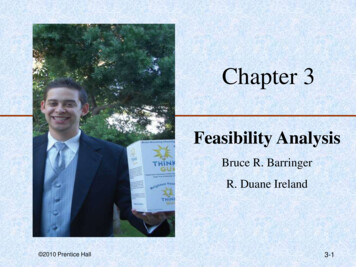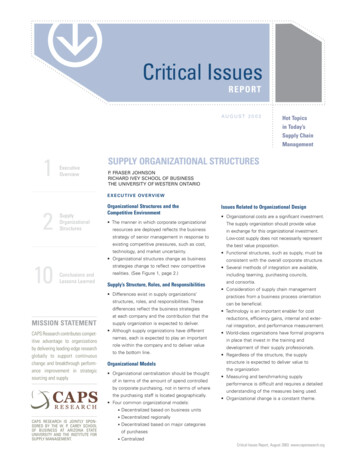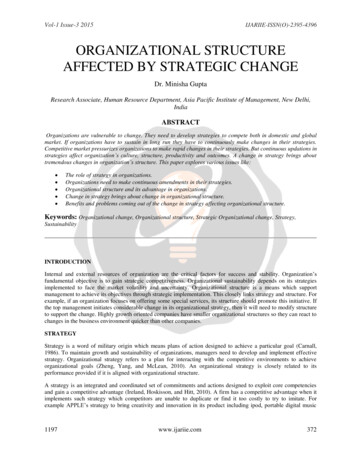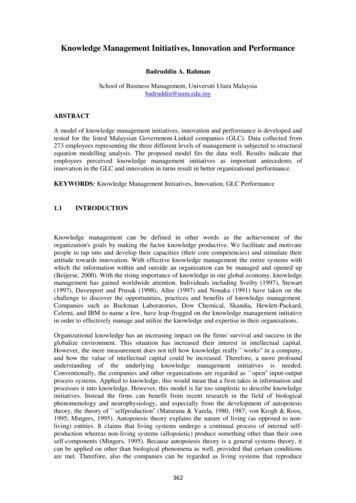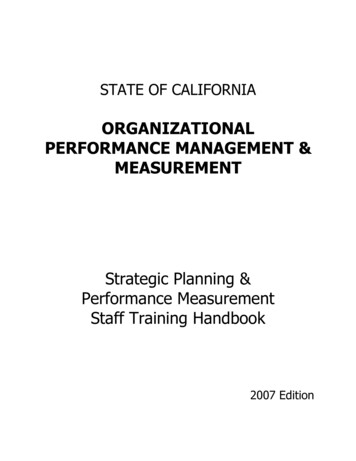
Transcription
STATE OF CALIFORNIAORGANIZATIONALPERFORMANCE MANAGEMENT &MEASUREMENTStrategic Planning &Performance MeasurementStaff Training Handbook2007 Edition
Credits and UseCREDITSThis handbook was developed under the direction of Dr. Denzil Verardo for theCalifornia Performance Review. It was approved by the Office of GovernorSchwarzenegger in July, 2004 for delivery to state agencies. The Handbook involvedmany state employees during its formative stages and later implementation stages. Thehandbook preparation team included:Rita Escobar, Ann Evens, Dr. David Illig, Sue Loustalot, Norma Ortega, NicolasSchweizer, Jennifer Shaffer and Cindy Woolston.The original training preparation team included:Mary Fernandez , Mary Veliquette, Jennie Verardo, Tom Ward, and Pete Williams.Subsequent editions, under the purview of the State Personnel Board, were modifiedbased on feedback and new materials by Jennie Verardo, Pete Williams and Dr. DenzilVerardo.USEThe material contained in this handbook may be freely copied with a credit line to theCalifornia Performance Review.July, 2007
TABLE OF CONTENTSINTRODUCTION. . . . . . . . . . . . . . . . . . . . . . . . . . . . . . . . . . . . . . . . . . . 1Performance Management Cycle . . . . . . . . . . . . . . . . . . . . . . . . . . . . . . 2About this Handbook . . . . . . . . . . . . . . . . . . . . . . . . . . . . . . . . . . . . . . . . 4I. A GUIDE TO STRATEGIC PLANNING. . . . . . . . . . . . . . . . . . . . . . . . 5What is Strategic Planning . . . . . . . . . . . . . . . . . . . . . . . . . . . . . . . . . . . .5The Purpose of Planning . . . . . . . . . . . . . . . . . . . . . . . . . . . . . . . . . . . . . 5The Strategic Planning Process . . . . . . . . . . . . . . . . . . . . . . . . . . . . . . . . 7Do We Need to Change Direction? . . . . . . . . . . . . . . . . . . . . . . . . . . . . .19II. PERFORMANCE MEASUREMENT AND MANAGEMENT. . . . . . . . 20Performance Measurement -- How Do We Measure Progress? . . . . . . . 20Why Measure? . . . . . . . . . . . . . . . . . . . . . . . . . . . . . . . . . . . . . . . . . . . . 24Developing and Using Performance Measures . . . . . . . . . . . . . . . . . . . . 26Key Steps for Using Performance Measures. . . . . . . . . . . . . . . . . . . . . 32The relationship of support and administrative programsto Agency Mission and Core Programs . . . . . . . . . . . . . . . . . . . . . . . . . . 34Final Links . . . . . . . . . . . . . . . . . . . . . . . . . . . . . . . . . . . . . . . . . . . . . . . . 36APPENDIXAppendix A: GlossaryAppendix B: Worksheets
CALIFORNIA STATE PERFORMANCE MANAGEMENT HANDBOOKIf you don’t know where you’re going, how are you gonna’ know when you get there?Yogi BerraINTRODUCTIONPerformance management is the unified use of strategic planning, performancemeasurement, budgeting for results, and performance review. Performance budgetingis the use of performance management to tie program funding to demonstratedoutcomes. The approach suggested in this handbook instructs agencies to: Identify the needs and demands of their customer/clients and the programsthat meet those needs; Establish clear, measurable outcomes for those programs; and Produce and maintain a formal system of accountability and use information inbudget development.This fully-integrated process helps California state government become more creative,flexible, focused, and accountable in responding to customer/client needs. performancemanagement allows programs to direct scarce resources toward high priority and wellperforming programs and services. Ultimately, the collection of techniques outlines inthis handbook will, when fully integrated or implemented, enhance the performance ofthe public sector by improving the ability of California government to produce results.Implementing a performance management system requires the simultaneousimplementation and use of several components. At higher levels, performancemanagement links strategic planning and performance concepts with budgetdevelopment. At the program level, performance management links strategic plans toannual action plans, budget requests, and annual performance reviews – all driven byoutcome-based performance measures.
The Performance Management Cycle shown on the next page illustrates the linkagesbetween: The development of a strategic plan; The identification of performance measurements; The connection of budgeting resources for program implementation anddesired results; The review of performance; and The revision of the plan if necessary.The goal is accountability and quantifiable results that maximize the resources ofCalifornia
The Performance Management CycleIn practice, the cycle isnot ipbetween keycomponents
ABOUT THIS HANDBOOKThis handbook was originally developed by the California Performance Review and thenminimally modified for use with the Performance Management training sponsored by theCalifornia State Personnel Board. The intent of the handbook and the training remainshelping agencies better engage in the performance management process. It isdesigned to assist agencies as they integrate planning, performance, and budgetingpractices with overall agency management.The California State Performance Management Handbook is divided into four parts:I.A Guide to Strategic PlanningII.Performance Measurement and ManagementIII.Annual Performance ReportsIV.Appendices (Glossary and forms)
I.A GUIDE TO STRATEGIC PLANNINGWhat is Strategic Planning?Strategic planning is planning for results. Strategic planning is a long-term, futureoriented process of assessment, goal setting, and strategy building that maps anexplicit path between the present and a vision of the future. Strategic planning relieson careful consideration of an organization’s capabilities and environment, and leadsto priority-based resource allocation and other decisions. It is a disciplined andcreative effort to produce fundamental decisions and actions that shape and guidewhat an agency is, what it does, and why it does it.A strategic plan is an agency’s comprehensive plan to address its businessneeds – to successfully carry out its mission. Because strategic planning is a teameffort that builds consensus on an agency’s future direction, the process itself can beas important as the resulting plan.The Purpose of PlanningThe purpose of planning is to provide an organization with a comprehensive andorderly structure for identifying its goals; and developing strategies and securing theresources needed to reach its desired outcomes. Planning enables an organizationto: Prepare for contingencies that could prevent it from attaining its goals; Develop a framework for its orderly growth and progress; Form the base for annual resource needs and the allocation of resources ina manner that will allow it to meet its goals and objectives; Provide for accountability based on results – how services make adifference to customer/clients; and Link its results to funding in a way that identifies what taxpayers get for theirtax dollars.
Mission & VisionStrategic PlanningEnvironmentalScanAnalysisMission & VisionCheckGoalsStrategiesObjectivesSWOT
The Strategic Planning Process1. Select the Strategic Planning TeamThe Strategic Planning Team serves as the oversight and coordinating body of theplanning process. In selecting the members of the team, address the followingquestions: Do the planning team members represent diverse areas and interests? Do they possess a variety of strengths, knowledge and skills? Are the knowledgeable about the agency? Are they knowledgeable about the primary customers or clients? Are they influential and persuasive with their constituents? Do they have access to, and an interest in, the long-term direction of the agency? Do they have the time and energy to commit to the strategic planning process? Can and will each member make a significant contribution to the planning effort?2. Develop the Strategic Plan FrameworkThe Strategic Planning Team needs to address the following issues to guide the overallprocess: What is the scope of the Strategic Plan? What is the length of time in the Plan period? How many years? What is our purpose in completing this planning process? Who should be involved in the Plan development and how? Who should review the Plan? What is the timeframe for completing the Plan? Who will manage the overall planning effort? What are the action steps needed to complete the Plan? Who is responsible for completing the action steps? When to the action steps need to be completed?3. Identify Governor’s Priorities and Legislative MandatesIn addition to legislative mandates, agencies operate within an Administration where theGovernor has priorities. An understanding of these priorities and the agency’s role in
supporting the Governor’s agenda is essential for the Administration to operatesuccessfully and ensure that limited resources are used judiciously.To fully consider the legislative mandates, statutes and budget language that direct theagency, the following should be completed: Identify citations. Identify the underlying purpose of mandates. Identify primary requirements. What programs are required? Consider the degree of flexibility in meeting mandates. Is there a shared responsibility in meeting mandates? Determine the current status of meeting of mandates. Based on the Governor’s priorities, do legislative changes need to be proposed?4. Conduct an Internal/External Assessment (SWOT Analysis)The Internal/External Assessment (SWOT Analysis) is an analysis and evaluation of keyinternal and external data and factors that influence the success of an agency inachieving its Mission and Goals. It should be the first step in any plan development.An assessment of an agency’s position, performance, problems and potential – in otherwords, its Strengths, Weaknesses, Opportunities, and Threats – is critical forunderstanding the context within which the planning occurs. This inventory, also calleda SWOT Analysis, looks both at the internal and external situation of the agency. Internal Assessment: Determine past performance. Have the customer/clients been satisfied? What has been the quality of our products and services? Have there been internal changes? Determine current status of the agency’s performance. Are customer/clients currently satisfied? What is being accomplished by the agency? What is not beingaccomplished?
What is the quality of the agency’s products and/or services? What are the existing programs? Are we currently measuring performance? Determine Strengths and Weaknesses. What is the agency’s capacity for change? Assess the status of the agency’s workforce, experience, traininglevel, morale, Information Technology support level, data systemsand capital assets. External Assessment Determine factors that influence the agency’s external environment suchas economic trends and forces, the political arena, the socialenvironment, and technological trends. Determine how these factors may change in the future. Which of these factors will enhance the agency’s ability to succeed(opportunities), which will hinder success (threats)?5. Identify Customer/clients and Stakeholders and what their expectations are. Customer/client – anyone who receives or uses the products or services ofthe agency. Stakeholder – any person or group with a vested interest in, or withexpectations of a certain level of performance or compliance from an agency.
SWOT LEXTERNAL
Analysis of THREATS(Nullifying Responses)AnalysisOPPORTUNITIES(Amplifying Responses)EnvironmentalScanAmplifyingResponsesWhat weWANT todoWhat weMUSTdoWhatCANWeDo?
6. Preparing the Plan Prepare the Mission statementA Mission statement states an agency’s unique reason for existence. It isusually contained within a brief, formal statement of the agency’s purpose.Mission statements should consider the following questions: Who are we? What do we do? Why do we do it? For whom do we do it? Why are public resources devoted to this effort?A Mission statement needs to: Identify the overall purpose for the existence of the agency. Identify the basic needs or distinct problems that the agency isdesigned to address. Identify the agency’s customers, clients or users. Help identify customer/client and stakeholder expectations, andrequirements; services and products provided to meet theserequirements; and processes and resources used to satisfy therequirements. Lead to the development of performance measures that reflectcustomer/client and stakeholder requirements.A Mission statement must reflect the present view of how to turn the VisionStatement into reality. Prepare the Vision statementA Vision statement is a compelling, conceptual and vivid image of the desiredfuture. It is a brief statement that serves to provide clear direction andmotivation for pursuit of a better future. While it should represent a “stretch”
for the agency, it must be a challenging, guiding vision of success and shouldbe attainable. Prepare the Values statementA Values statement is a statement of an agency’s core values, describinghow the agency conducts itself in carrying out its mission. It providesguidance for staff, customers/clients and others regarding the principles thatunderlie the agency’s conduct. An agency’s Value statement reflects theagency’s attitude about: People – the way that employees and customer/clients are treated. Processes – the way that the agency is managed, decisions aremade, and products and services are provided. Performance – the expectation concerning the agency’sresponsibilities and the quality of its products and services.Sample Values statement:We value:Employees – We care about each other, encourage growth and recognizeaccomplishments.Customers/clients – Our first priority is to satisfy our customers/clients.Quality – We do the right things right the first time.Improvement – We do the right things better the next time.Integrity – We are committed to the highest standards of ethical behavior.Leadership – Leaders are inspiring and lead by example. Leadershipexists at all levels. Identify the GoalsGoals are statements of the desired end results – generally after five years ormore – for which the agency is striving. Goals should focus on outcomes andmust support the attainment of the Mission and Vision. They set the strategicdirection of the organization.Well-written Goals:
Are in harmony with the agency Mission. Focus on outcomes and are qualitative in nature; but can includeperformance indicators to track progress toward goal achievement. Upon achievement, will help the agency fulfill its Mission. Are consistent with the agency’s enabling legislation. Are derived from the internal/external assessment and reflect criticalissues. Are innovative, original, ground-breaking and pioneering. Are challenging. They raise the bar, yet they are realistic. Provide clear direction for agency action. Describe a future, desired state for the agency’s customers/clients. Reflect agency priorities. Are broad and not measurable. Do not conflict with each other.Steps for identifying Goals: Establish the process. Review internal and external assessment data. Incorporate customer/client and stakeholder feedback. Analyze gaps in service. Set direction to achieve desired results. Draft Goals. Select Goals to include in the Strategic Plan. Develop StrategiesOnce “where we are” (Internal/External Assessment) and “where we want tobe in the future” (Mission, Vision and Goals) are determined, Strategies forgetting to our desired destination must be developed.
Strategies are descriptions of how the organization proposes to achieve itsGoals. They both inform the agency’s customers/clients and stakeholdersabout the agency’s general plan for achieving its Goals and provide directionand guidance to program staff as they develop detailed Action Plans for theagency’s core programs. The core programs are directly linked to the Missionof the agency and represent distinct business functions, programs or activitieswhich emanate from the Mission. Strategies are valuable because they linkcore program actions to the overall agency Goals and Objectives.Strategies need to be: Clear and easy to understand. Descriptive of the agency’s function, the goods or services provided. Consistent with the agency’s enabling legislation.Questions to consider when developing strategies are: Does the strategy directly address the agency’s high priority Goalsand Objectives? Which specific Objective does the Strategy help to achieve? Will this strategy help the agency make progress toward itsObjectives? In light of the agency’s Goals and Objectives, what should be donedifferently? Are there other ways to achieve the Goals and Objectives? Are there other agencies that complement or conflict with theagency’s goals? What Strategies would reconcile or mitigate anyconflicts? Identify the ObjectivesObjectives are specific, measurable and time-dependent targets foraccomplishment of a goal. Achievement of Objectives should result in theeventual achievement of the Goals. They form the central feature of annual
Action Plans because they drive development of the action steps of the ActionPlans.Objectives should be S.M.A.R.T.Specific – give specificity to the goal and define specificallyMeasurable – measure where the agency is now and where it wants to beAchievable – are challenging, yet attainable; realisticResults-oriented – focus on outcomes not functions or servicesTime-certain – specify a timeframe for being achievedObjectives need to: Relate to the organization goal. Address the citizen or customer/client condition. Be broad and measurable. Be challenging and ambitious.
Action PlansAn Action Plan reflects the strategies identified in the agency’s Strategic Plan andprovides a detailed description of the key action steps needed to accomplish eachObjective. Action Plans are operational documents because they describe what willoccur during that year. Since resources needed to carry out the Action Plans areidentified, budget requests for program Action Plans are justified in part by how closelythey support agency Goals and Objectives. They need to answer the question, “Howwill this Action Plan move the agency closer to achieving its Goal(s)?” Action Plans are separate from, but implement, the agency’s StrategicPlan. Action Plans are linked to the agency’s Strategic Plan because they detailhow the identified Strategies are carried out during the one-year period. Action Plans are developed annually, on a fiscal-year basis, and theydescribe the work for a one-year segment in a multi-year planning effort. Separate Action Plans are needed for each Strategy the agency expects toimplement during the fiscal year.The success of performance management requires that Action Plans includeperformance targets. The Action Plan must Include quantitative measures of outputsand outcomes identified in it. These measures specify the amount of change soughtduring the year. While the Action Plan is an annual plan, the cumulative effect ofreaching the performance targets each year should result in Goal attainment by the endof the strategic planning period.Developing Action PlansThe process for putting together an Action Plan is to: Identify the key people responsible for implementing the Action Plan.Ensure that they are involved in developing the plan. Detail the Action Plan steps. Identify who is responsible for completingeach step by what specific date.
Set the timeframe for completing the Action Plan as a whole. Ensure thatthis timeframe is reasonable considering the time needed to complete theindividual steps. Determine the fiscal effects and identify the resources needed to carry outthe plan. This becomes the basis for developing requests for capital,operating and personnel budgets.
Do We Need to Change Direction?Performance Management requires good, verifiable information on performance,and assessments of what went right and what went wrong. These assessmentsserve to guide both future program level annual Action Plans and departmentand agency Strategic Plans. The level of review is the program, and allassessments must include an assessment of Goal and Objective attainment.This requires an analytical strategy that also looks beyond programs and specificaction steps. The analysis asks whether the program, department, and agencyachieved their performance targets. To that end, several issues must beexamined: Analysis of actual achievement compared to target levels chosen at thebeginning of the plan; Examination of performance trends and implications of those trends; Discussion of internal and external reasons if targets were not attained; Assessment of resource adequacy for the tasks set out in the ActionPlan; Discussion of the completeness or adequacy of performanceinformation; Assessment of how partner agencies performed in achieving sharedObjectives and Goals; and Recommendations for changes needed in future Action Plans and toStrategic Plans.
II.PERFORMANCE MEASUREMENT AND MANAGEMENTPerformance Measurement – How do we measure progress?Once the strategic planning process is complete and the Vision, Mission and Goalsare in place and defined, it is necessary to create a method for measuring theprogress and success of the organization. Identifying Core Programs and thenchoosing a balanced set of performance measures is an essential – and often themost difficult – part of the performance management process. Performancemeasurement is integral to linking the overall agency Mission and the financialdecisions that drive its activities. Performance measures are indicators of thedegree to which an agency is meeting its stated desired outcomes. In addition, aperformance management system deploys the strategic plan and both focuses andaligns agency efforts with customer expectations.Measuring progress towards accomplishing goals and objectives is one of the mostimportant aspects of a performance management system. By measuring progress,an agency can determine if the actions they are implementing are moving theorganization closer to achieving its goals and objectives. Through the strategicplanning process, goals and objectives that specify outcomes or results the agencyis striving to achieve are developed. However, focusing on results requires two keyprocesses: Performance Measures and Indicators. Performance measures andindicators ensure accountability. While the primary focus of performancemeasurement is on results, performance measures also include measuresof inputs, processes and outputs. Performance measures work best if theyrelate directly to goals and objectives and measure outcomes rather thanjust inputs, processes or measures.An agency’s goals are defined in qualitative terms. However, CoreProgram managers and oversight agencies will want, and need, information
on inputs and outputs to determine program effectiveness and/or efficiency.Managers will be expected to produce information about the efficiency ofthe Core Programs in delivering the services designed to achieve goals andobjectives. Monitoring and Tracking Systems. Monitoring and tracking systemscapture performance information about Core Programs and report onperformance measures on a regular basis. They are used to compilemanagement information and keep the plan on track. Such systems mustbe flexible and easily accessed. Further, they must have the capacity tolink to other financial reporting systems and be capable of producing ad hocreports.
Mission & VisionPerformance Measurement ModelCore ProgramCore ProgramCore lysisTargets
Performance Measurement 7IdentifySourcesOf Data4ListActivities5DevelopMeasures6Select VitalFew Measures
Why Measure?What gets measured gets done! The organization must keep moving forward with areal sense of urgency and with action plans that deliver measurable results. In spite ofthe difficulties involved, measurement should be done because: Measuring performance provides for agency accountability – performancemeasures let individuals and organizations know how well the agency is doing,and whether it is doing what it said it would do. Measuring performance encourages government responsiveness –measurement data makes government more responsive to public needs. Measuring performance provides management and others with information onthe degree of Mission accomplishment. Measuring performance creates a blueprint for linking budget to outcomes. Measuring performance allows for the tracking of improvements and revealswhat is working and what is not. Measuring performance reinforces desired behaviors. Measuring performance is good management since it provides information andaccountability at all levels of government. It also helps managers and employeesfocus on what is important. Measuring performance brings greater clarity to the budget process and providesthe customer with a meaningful sense of results that are, and will be, attainedwith their tax dollar. Measuring performance pulls the agency toward a vision and createsorganizational alignment. Measuring performance drives action and promotes results. Measuring performance provides focus and drives organizational capacity.
SOME TIPS ON MEASUREMENT Measure what is important strategically and/or what is of value to customers/clients, not just what is easy to measure or is already being measured.Measure what you are responsible for.Within areas of responsibility – whether core or support programs – keep measures to the“vital few” critical indicators.Measure what you can control, directly or indirectly. The more direct the control, the moreaccurately you will be able to assess your impact.Consider multiple measures to assess an outcome.If you have confidence in the data, use the information you already have.Ask your customers/clients what to measure.Ensure that the process of measurement is clearly separated from the process of evaluation.“Nice to know” data is nice to know but is probably not worth the effort to collect. A goodmeasure is one that is used.Measures must be actionable to be valuable.Be sure that the data really says what you think it says. There may be some uncertaintiesand you may make some mistakes in measurement selection until they are tested.Occasionally, there is not a readily-available measure for a specific program or function. Inthose cases, you must invent the measure and begin collecting the data.A Working OrganizationInputInputOutputInputOutputInputInput
Developing and Using Performance MeasuresThe Formula for defining Core Program Outcome Measurement: Key Steps fordeveloping Performance MeasuresMany individuals view measurement as difficult and complex, but acceptance of themeasurement process is essential to its success as a performance improvementtool. Like strategic planning, the process by which you determine what to measure,how to measure and how to use the measures is as important as the product itself.Performance measures address resources consumed by the system (inputs), theefficient delivery of program activities (processes), the direct services delivered by aprogram (outputs), and the results of those services (outcomes). One to display therelationship among these measures is the “MeasurementChain.”The Measurement ChainResourcesconsumed bythe system ( ,equipment,humanresources)Steps toproduceoutput (cycletimes/errorrate)Amount ofwork done(units of workdone)Results (customersatisfaction,accomplishment,quantifiable impacton customer)
Input Process Output OutcomeProgram managers and others can use the following seven-step process to developCore Programs and Performance Measurements:1. Define your Mission. Gain consensus from your internal and externalcustomers/clients. The key question to ask is, “What is our business and whomdo we serve?”2. Determine Core Programs. Look for action words in the Mission and Goals.Identify what the agency does and break it into its major components. Looks forhints from the agency structure such as “water quality division,” “resourcemanagement division,” or “drug enforcement division.” Look at budgetdocuments and funding. But don’t get stuck there. Look at the Goals thatprograms address. Translate the action words from the Mission and otherdocuments into the distinct business functions or activities of the agency. Theseare the Core Programs. A Core Program is a group of services sharing acommon purpose designed to achieve a related outcome. “Test” the CoreProgram against the following questions (you will be looking for “yes” answers): Is the program mentioned specifically in statute? Does the program respond to a high priority or sensitive public policyissue? Is the program unique, Mission-related, and distinct from other programs? Are significant public resources dedicated to the program?3. Identify Outcomes. Outcomes are the conclusion of core functions. They arethe results of activities which accomplish the Mission; the end-product of serviceto the customer/client; or a concise description of the result(s) of Core Programs.“A safe public,” “a drug-free educational environment,” “a quality infrastructure”are some examples of outcomes for some State programs.4. Identify the main activities associated with each program. The operativewords are main activities. These are the most important work functions whichmake up a program. Don’t dwell on minutia. For example, if your Mission is the
“care and treatment of men and women who ha
The intent of the handbook and the training remains helping agencies better engage in the performance management process. It is designed to assist agencies as they integrate planning, performance, and budgeting practices with overall agency management. The California State Performance Ma
